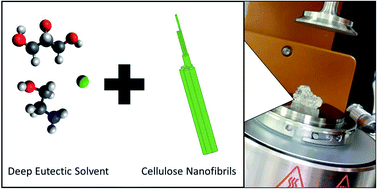Non-volatile conductive gels made from deep eutectic solvents and oxidised cellulose nanofibrils†
Abstract
Ionogels offer huge potential for a number of applications including wearable electronics and soft sensors. However, their synthesis has been limited and often relies on non-renewable or non-biocompatible components. Here we present a novel two-component ionogel made using just deep eutectic solvents (DESs) and cellulose. DESs offer a non-volatile alternative to hydrogels with highly tuneable properties including conductivity and solvation of compounds with widely varying hydrophobicity. DESs can be easily made from cheap, biodegradable and biocompatible components. This research presents the characterisation of a series of soft conductive gels made from deep eutectic solvents (DESs), specifically choline chloride-urea and choline chloride-glycerol, with the sole addition of TEMPO-oxidised cellulose nanofibrils (OCNF). A more liquid-like rather than gel-like conductive material could be made by using the DES betaine–glycerol. OCNF are prepared from sustainable sources, and are non-toxic, and mild on the skin, forming gels without the need for surfactants or other gelling agents. These DES-OCNF gels are shear thinning with conductivities up to 1.7 mS cm−1 at ∼26 °C. Given the thousands of possible DESs, this system offers unmatched tunability and customisation for properties such as viscosity, conductivity, and yield behaviour.



 Please wait while we load your content...
Please wait while we load your content...